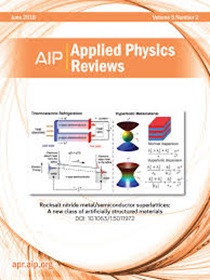肿瘤液体活检中单个细胞外囊泡分子分析的纳米技术
IF 11.6
1区 物理与天体物理
Q1 PHYSICS, APPLIED
引用次数: 0
摘要
细胞外囊泡(EVs)作为一种很有前途的癌症生物标志物,由于它们包封了反映肿瘤细胞起源的分子信号。传统的分析方法在全面的EV分子分析中往往不足,需要创新的方法来提高灵敏度和选择性。本文综述了纳米等离子体结构在电动汽车光信号检测中的应用,探讨了单电动汽车分子谱分析的进展、挑战和未来展望。纳米等离子体结构提供了增强的光学读出能力,利用光的虹彩,以及适合电动汽车尺寸范围和复杂性的等离子体放大。我们深入研究了芯片上方法的研究和影响,揭示了电动汽车在健康和疾病中的作用。尽管取得了显著进展,但仍有机会进一步开发纳米等离子体阵列,为感兴趣的生物分析物定制纳米等离子体阵列,这对于无标记和标记技术实现其EV分析目标至关重要。其中一个例子是在纳米等离子体阵列中使用特异性抗体进行表面功能化。其他方法包括根据目标电动汽车的物理特性定制平台设计,从而增强表征能力。随后的部分将涵盖相关研究的精选。稍后,我们将讨论通过等离子体纳米阵列在临床样品场景中的EV分析。虽然胶体自组装和电子束光刻等图像化方法可以与微流体系统集成,促进未来的研究,但很少有技术进入临床试验。这一障碍突出了进一步开发成本效益高、详细的分子分析方法的必要性。此外,我们还讨论了单个电动汽车分析和机器学习等途径,以解决电动汽车作为液体活检生物标志物的异质性相关挑战。最后,我们讨论了发展纳米等离子体辅助EV分析的未来机会,并研究了其在诊断和治疗领域的推动进展,例如可定制的纳米等离子体结构与人工智能分析模块相结合,作为精确EV分子分析的前进道路,这可能使个性化的治疗干预成为可能。本文章由计算机程序翻译,如有差异,请以英文原文为准。
Nanoscopic technologies toward molecular profiling of single extracellular vesicles for cancer liquid biopsy
Extracellular vesicles (EVs) have emerged as promising cancer biomarkers due to their encapsulation of molecular signals reflective of originating tumor cells. Conventional analytical methods often fall short in comprehensive EV molecular profiling, necessitating innovative approaches for enhanced sensitivity and selectivity. This review focuses on the utilization of nanoplasmonic structures for optical signal detection of EVs, exploring advancements, challenges, and future prospects toward single EV molecular profiling. Nanoplasmonic structures offer enhanced optical readout capabilities, leveraging light iridescence, and plasmonic amplification suitable for the size range and complexity of the EVs. We delve into the research and implications of on-chip methods, shedding light on EVs' role in health and disease. Despite notable progress, opportunities still exist to further develop nanoplasmonic arrays, customizing them for bioanalytes of interest, crucial for both label-free and labeled techniques to attain the objectives of their EV profiling. One such example is the use of specific antibodies for surface functionalization in nanoplasmonic arrays. Other approaches involve tailoring the design of platforms to the physical properties of target EVs, thereby enhancing characterization capabilities. The subsequent sections will cover a curated selection of relevant studies. We later discuss EV analysis through plasmonic nanoarrays in clinical sample scenarios. While patterning methods, such as colloidal self-assembly and e-beam lithography, enable integration with microfluidic systems, facilitating future investigations, few technologies have entered clinical trials. This roadblock highlights the need for further development of cost-effective, detailed molecular profiling methods. Moreover, we discuss avenues like single EV profiling and machine learning to address challenges related to heterogeneity of EVs as liquid biopsy biomarkers. Finally, we discuss future opportunities in developing nanoplasmonic-assisted EV profiling and studied their driving advancements in diagnostic and therapeutic realms, such as customizable nanoplasmonic structures coupled with artificial intelligence analysis modules, as a path forward for precise EV molecular profiling, which may enable personalized therapeutic interventions.
求助全文
通过发布文献求助,成功后即可免费获取论文全文。
去求助
来源期刊

Applied physics reviews
PHYSICS, APPLIED-
CiteScore
22.50
自引率
2.00%
发文量
113
审稿时长
2 months
期刊介绍:
Applied Physics Reviews (APR) is a journal featuring articles on critical topics in experimental or theoretical research in applied physics and applications of physics to other scientific and engineering branches. The publication includes two main types of articles:
Original Research: These articles report on high-quality, novel research studies that are of significant interest to the applied physics community.
Reviews: Review articles in APR can either be authoritative and comprehensive assessments of established areas of applied physics or short, timely reviews of recent advances in established fields or emerging areas of applied physics.
 求助内容:
求助内容: 应助结果提醒方式:
应助结果提醒方式:


